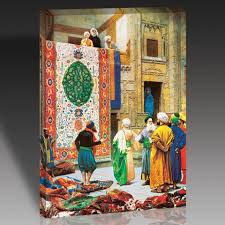Anatolian Turkish Rug

At present, it is impossible to prove exactly when and where rug weaving began, as there is no reliable source, but it can be traced back as early the Neolithic age (7000 B.C.). The first examples consisting of warp and weft were textile products which resembled flat weave kilims. Then rugs were created by forming knots to make a pile. According to scientist, rug weaving must have originated in the dry steppe regions where the nomadic tribes lived. Central Asia was a suitable location for the first rug-weaving center because of the availability of land for herding sheep and because of the climate of the region.
Rugs have been used in the home as floor coverings, blankets, tablecloths and decorations. They acquire value as they are used, whereas most objects decrease in value over time.
The oldest example known in the history of hand-make rugs is the one which is exhibited in the St. Petersburg Hermitage Museum in Russia. This fantastic Altai rug was discovered by the Russian archaeologist Sergei Rudenko in the year 1949 and is known as the “Pazirik Rug”, woven around the 3rd century B.C. The majority of experts believe that there is a link between ancient Turkish culture and this particular rug; they also believe that the other items found in the Pazirik Tumulus have some connection to Turkish civilization.


The art of rug weaving which began with the Selcuks continued with the Ottoman Turks. After the Selcuk Turks and before the Ottomans, during the transition period in the 14th century, animal figures began to appear on the rugs. Although very few of these exist today, they can be seen in the paintings of famous Italian, French and Dutch painters. Due to the animal figures on these rugs, they are called as “Rugs with Animals”.
By the 15th century there was a wider variety of animal motifs on the rugs. A new group of rugs with a combination of animal motifs and geometrical patterns appeared around this time. These rugs were called “Holbein Rugs” since they appear in paintings by the German artist Hans Holbein. As there are no surviving examples of these rugs today, all research is carried out from the paintings. The works of artists such as Lotto, Memling, Carlo Crivelli, Rafaellino de Gardo, B.Van Orley, Carpaccio, Jaume Huguet were also important sources of research. In this century, Bergama and Usak became important weaving centers in western Anatolia.
The 16th century was the beginning of the second successful period of Anatolian rug-weaving. The rugs from this period are called “Classical Ottoman Rugs”. The reason these rugs are called “Palace rugs” is that the design and colors would have been determined by the palace artists and then sent to the weaving centers. this method was similar to that used in the ceramic tile production of that period.
The designs, which consisted of twisting branches, leaves and flowers such as tulips, carnations and hyacinths, are woven in a naturalistic style and establish the basic composition of the rug. This style was continued in other regions and can be seen in Turkish rugs today.
In the 16th, 17th and 18th century, Gördes, Kula, Milas, Ladik, Mucur, Kirsehir, Bandirma and Canakkale gained importance as rug-weaving centers, along with Usak and Bergama. The rugs woven in some of these areas are known as “Transylvanian Rugs” because they were found in churches in Transylvania.
In the beginning of the 19th and 20th centuries, the rugs woven in Hereke (nearby Istanbul) gained worldwide recognition. These rugs were originally woven only for the Sultans of the Ottoman Empire. The finest silk rugs in the world are still being woven in Hereke today.
We can identify the rugs woven in different regions as town or village rugs. The rugs woven in the agricultural areas of Anatolia owe their origins to the settlers or nomadic cultures. In Europe, these rugs (which are woven with wool on wool) are generally called “Anatolian Rugs” In towns where people have settled permanently, the rugs are woven with a wool on cotton combination.
Today in Turkey there are regions which keep this wonderful tradition alive; such rugs are woven in Konya, Kayseri, Sivas, Hereke, Yagcioglu, Kula, Dösemealti, Taspinar, Isparta, Milas, Bergama, Canakkale, Kars, Usak, Gordes, Fethiye and Yahyali.


